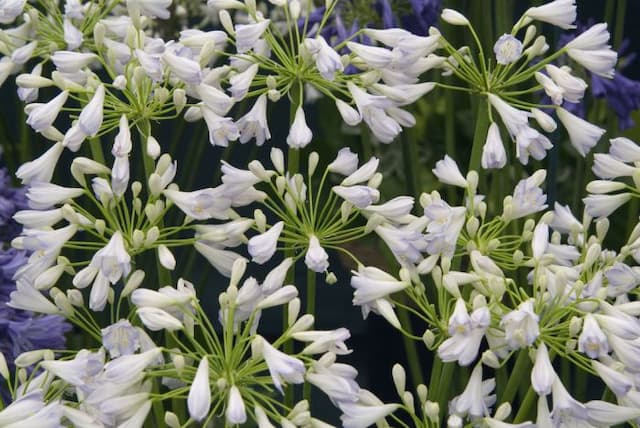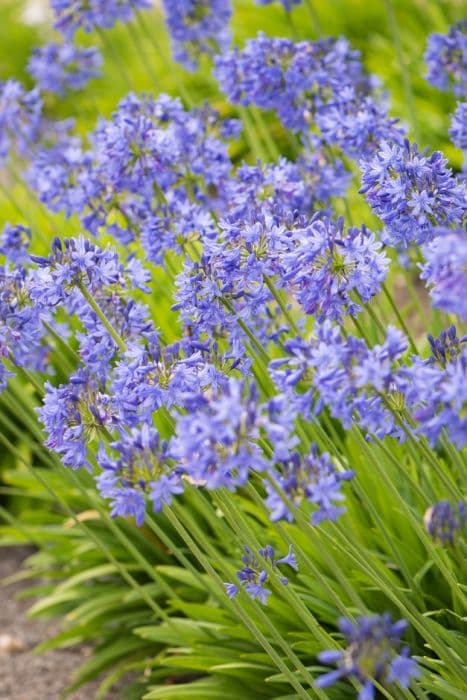African Lily Agapanthus Ever White = 'Wp001'
![African lily [Ever White]](/_next/image?url=https%3A%2F%2Fplants-admin.emdemapps.com%2Fimages%2Fplants%2F%2Fimages%2F604b6446289c6.png&w=3840&q=75)
ABOUT
Agapanthus Ever White, commonly known as the Lily of the Nile or African Lily, is a perennial flowering plant that is characterized by its attractive foliage and striking flowers. This variety has a clumping form, with strappy, glossy green leaves that create a lush backdrop for its blooms. The leaves are long and arching, emanating from the base of the plant in a fountain-like manner. The most distinctive feature of Agapanthus Ever White is its blooms. The plant produces tall, sturdy stalks that rise above the foliage, each topped with a large, rounded cluster of flowers. These flower clusters, or umbels, are composed of multiple individual trumpet-shaped flowers that are pure white in color, giving the plant its name 'Ever White'. The flowers are known for their elegance and can add a touch of sophistication to any garden setting. The blossoms are particularly attractive to pollinators, such as bees and butterflies, making this plant not only a visual highlight but also a contributor to the local ecosystem. The contrast between the deep green leaves and the bright white flowers creates a striking visual display throughout the blooming season. Despite lacking information on the specific dimensions of Agapanthus Ever White, its appearance suggests that it is a plant of considerable ornamental value, capable of making a significant impact in gardens, borders, or as a focal point in container plantings.
About this plant
 Names
NamesFamily
Amaryllidaceae
Synonyms
African Lily, Lily of the Nile, Love Flower
Common names
Agapanthus Ever White 'Wp001'
 Toxicity
ToxicityTo humans
The most common common name for Agapanthus Ever White 'Wp001' is Lily of the Nile. This plant is considered mildly toxic to humans if ingested. The toxicity can cause gastrointestinal symptoms such as nausea, vomiting, and diarrhea. In some cases, it may also cause skin irritation or allergic reactions when handling the plant.
To pets
Lily of the Nile is also toxic to pets, including cats and dogs. If ingested, it can cause symptoms similar to those in humans, such as vomiting, diarrhea, and nausea. In some cases, it may lead to more severe symptoms like tremors, abdominal pain, and salivation. Pet owners should keep their animals away from the plant to prevent poisoning.
 Characteristics
CharacteristicsLife cycle
Perennials
Foliage type
Evergreen
Color of leaves
Green
Flower color
White
Height
2 feet (60 cm)
Spread
2 feet (60 cm)
Plant type
Herb
Hardiness zones
8
Native area
South Africa
Benefits
 General Benefits
General Benefits- Easy Maintenance: Agapanthus Ever White generally requires minimal care once established, making it suitable for gardeners of all skill levels.
- Drought Tolerance: This plant is relatively drought-tolerant, reducing the need for frequent watering.
- Long Blooming Period: It produces flowers for an extended period, usually throughout the summer, offering long-lasting visual appeal.
- Attracts Pollinators: The blossoms attract bees and butterflies, which can help pollinate other plants in the garden.
- Landscape Versatility: Agapanthus Ever White can be used in a variety of landscaping applications, such as borders, containers, and as accent plants.
- Habitat Friendly: It provides shelter and food for various small wildlife, contributing to a healthy ecosystem.
- Aesthetic Appeal: The striking white flowers and lush foliage offer aesthetic beauty and can enhance the overall appearance of a garden or patio area.
- Works as a Filler: This plant is ideal for filling gaps in the garden, adding fullness and a touch of elegance.
- Soil Erosion Control: The root system of Agapanthus helps to stabilize the soil and prevent erosion.
- Easily Propagated: The plant can be easily propagated through division, allowing gardeners to expand their collection or share with others.
 Medical Properties
Medical PropertiesThis plant is not used for medical purposes.
 Air-purifying Qualities
Air-purifying QualitiesThis plant is not specifically known for air purifying qualities.
 Other Uses
Other Uses- Agapanthus, sometimes referred to as the African Lily, can be used as a natural dye to color fabrics. The blue and purple shades of the flowers can be boiled to extract the hues.
- The sturdy, long leaves of Agapanthus African Lily can be woven into baskets or mats, offering a sustainable crafting material.
- In frost-free climates, Agapanthus African Lily can be used as erosion control on slopes due to its robust root system.
- It serves as an excellent addition to floral arrangements, providing unique structure and height to bouquets due to its long-lasting flowers and stems.
- African Lily can be used in educational settings, such as schools and botanical gardens, to teach about pollination since it attracts bees and butterflies.
- In garden ponds or water features, Agapanthus can be placed in large pots to add vertical interest and a pop of color around the water's edge.
- The plant can be used as a natural ink source for artists looking for organic materials to create blue or purple hues in their work.
- African Lily may be incorporated into ceremonies or celebrations as a decorative element because of its striking flowers and association with love and fertility in some cultures.
- Used in landscaping as a living border, the African Lily creates visual structure and definition between different garden spaces.
- The seed pods of Agapanthus African Lily, when dried, can be used as natural rattles or added to decorative dried flower arrangements.
Interesting Facts
 Feng Shui
Feng ShuiThe Agapanthus, commonly known as the Lily of the Nile, is not specifically used in Feng Shui practice.
 Zodiac Sign Compitability
Zodiac Sign CompitabilityThe Lily of the Nile is not used in astrology practice.
 Plant Symbolism
Plant Symbolism- Love Letters: Agapanthus Ever White is often associated with love letters or messages, potentially due to its name Agapanthus, where 'agape' means love and 'anthos' means flower in Greek.
- Purity: The white blooms of the Agapanthus Ever White convey a sense of purity and innocence, making them ideal for celebrations like weddings or christenings.
- Beauty: With its elegant form and striking white flowers, this plant is commonly associated with beauty and can be given to acknowledge someone's attractiveness or grace.
- Strength: Despite its delicate appearance, Agapanthus is a hardy plant, symbolizing strength and resilience in adversity.
- Enduring Love: The long-lasting nature of the flowers and the perennial growth habit of the plant suggests a meaning of enduring or everlasting love.
 Water
WaterLily of the Nile, more commonly known as Agapanthus 'Ever White', should be watered deeply once a week, using approximately 1 gallon of water per plant each time during the growing season. In the absence of rainfall, you may need to water twice a week. During winter or in cooler climates, reduce watering to every couple of weeks, ensuring the soil doesn't completely dry out. Overwatering can lead to root rot, so allowing the soil to dry out slightly between waterings is essential. Always check the top inch of soil for moisture before watering.
 Light
LightFor Lily of the Nile, or Agapanthus 'Ever White', the best light conditions include full sun to partial shade. They thrive in a location that receives at least 6 hours of direct sunlight per day. However, in extremely hot climates, they benefit from some afternoon shade to prevent scorching. A spot that enjoys morning sunlight and dappled afternoon light would be ideal.
 Temperature
TemperatureThe Lily of the Nile performs best in temperatures between 60 to 80 degrees Fahrenheit. They can tolerate a minimum temperature of about 50 degrees Fahrenheit but should be protected from frost, which can damage the foliage and flowers. The maximum temperature for optimal growth is around 85 degrees Fahrenheit, beyond which they may require additional shade and water to stay healthy.
 Pruning
PruningPrune the Lily of the Nile, or Agapanthus 'Ever White', to remove spent flower stalks and encourage further blooms. Pruning is also necessary to remove any damaged or dead foliage, which can be done in early spring. Cutting back the plants by about one-third after blooming has finished in the summer can encourage a second flush of flowers. Pruning is generally recommended annually.
 Cleaning
CleaningAs needed
 Soil
SoilLily of the Nile thrives in well-draining soil with a pH range of 6.0 to 8.0. A mixture of loam, sand, and organic matter like compost is ideal to provide proper drainage and fertility. Mulching is beneficial to retain moisture and regulate soil temperature.
 Repotting
RepottingLily of the Nile generally needs to be repotted every 2 to 3 years, or when it becomes root-bound. They perform well when slightly crowded, so repotting is not needed frequently.
 Humidity & Misting
Humidity & MistingLily of the Nile prefers moderate humidity levels. However, it is quite adaptable and can tolerate drier air. There is no specific humidity level required, but avoid extreme dryness which can result in brown leaf tips.
 Suitable locations
Suitable locationsIndoor
Keep in bright light and maintain moist soil.
Outdoor
Plant in sunny spot, protect from frost, maintain moisture.
Hardiness zone
8-11 USDA
 Life cycle
Life cycleAgapanthus Ever White, also known as 'White African Lily' or 'Lily of the Nile', begins its life as a seed which germinates in warm, well-drained soil with sufficient light exposure. After germination, the plant develops a strong root system and long, strappy green leaves that form a clump. This evergreen perennial enters a vegetative stage where it focuses on leaf growth before transitioning into the flowering stage, typically in summer, producing tall stalks topped with umbrella-like clusters of white flowers. After flowering, seeds form and, if not deadheaded, can drop to the ground to start a new generation. In winter or cooler seasons, the plant may become dormant, reducing activity to conserve energy. Year on year, if conditions are favorable, the plant will continue to grow in size, with the clump expanding and producing more flower stalks each season.
 Propogation
PropogationPropogation time
Spring-Early Summer
The most popular method for propagating Agapanthus Ever White, commonly known as the Lily of the Nile, is through division. This is generally done in the late spring or early fall, when the plant is not in active bloom. To propagate by division, carefully dig up the clump of the plant, making sure to keep as many roots intact as possible. Gently separate the clump into smaller sections, each with a few shoots and a portion of the root system. Replant the divisions at the same depth they were growing at originally, spacing them about 12 to 18 inches (approximately 30 to 45 centimeters) apart to allow for growth. Water the new plantings well to establish them. This method allows the gardener to create new plants that are genetically identical to the parent plant, ensuring a consistent display of the Ever White's characteristic blooms.









